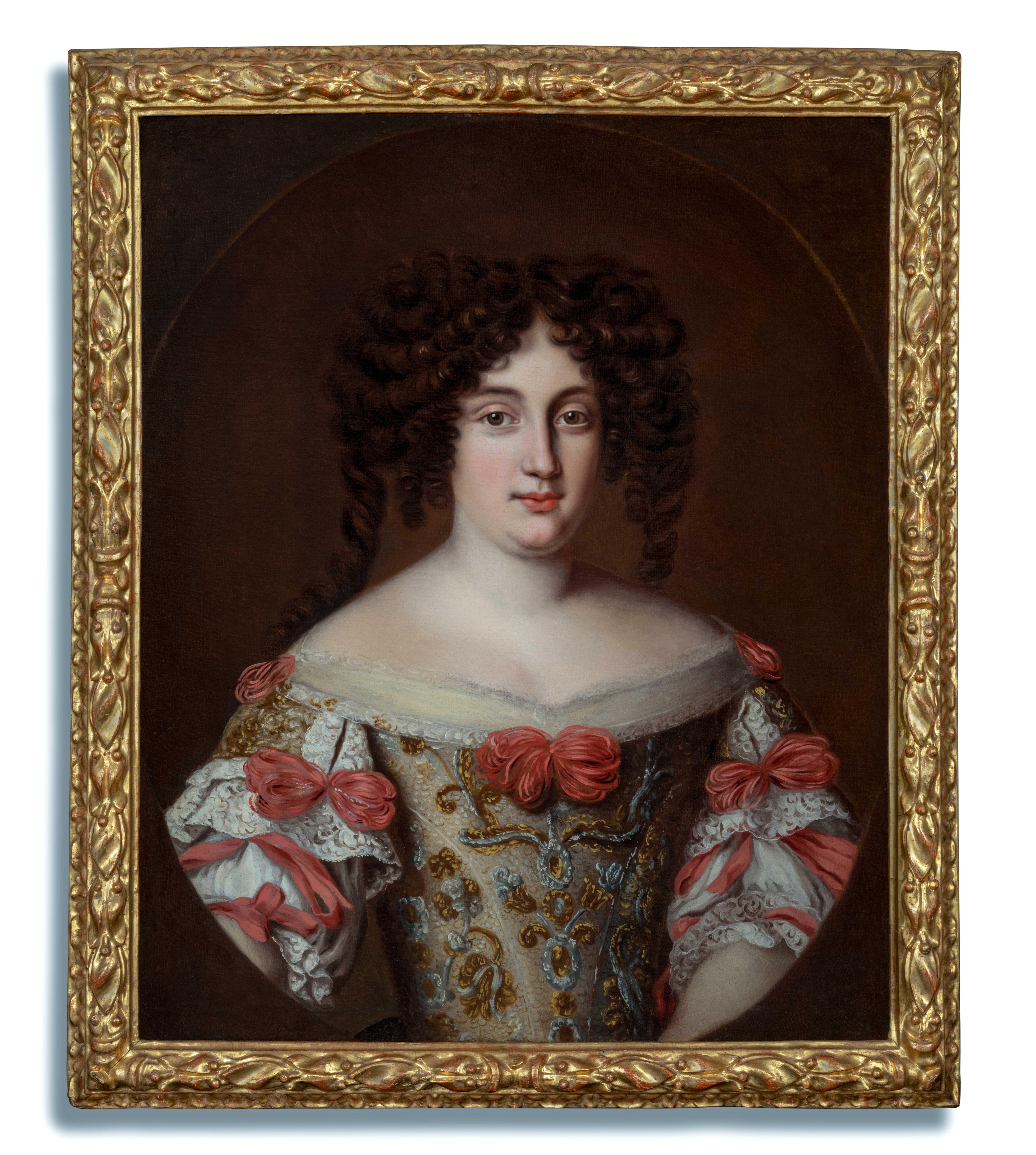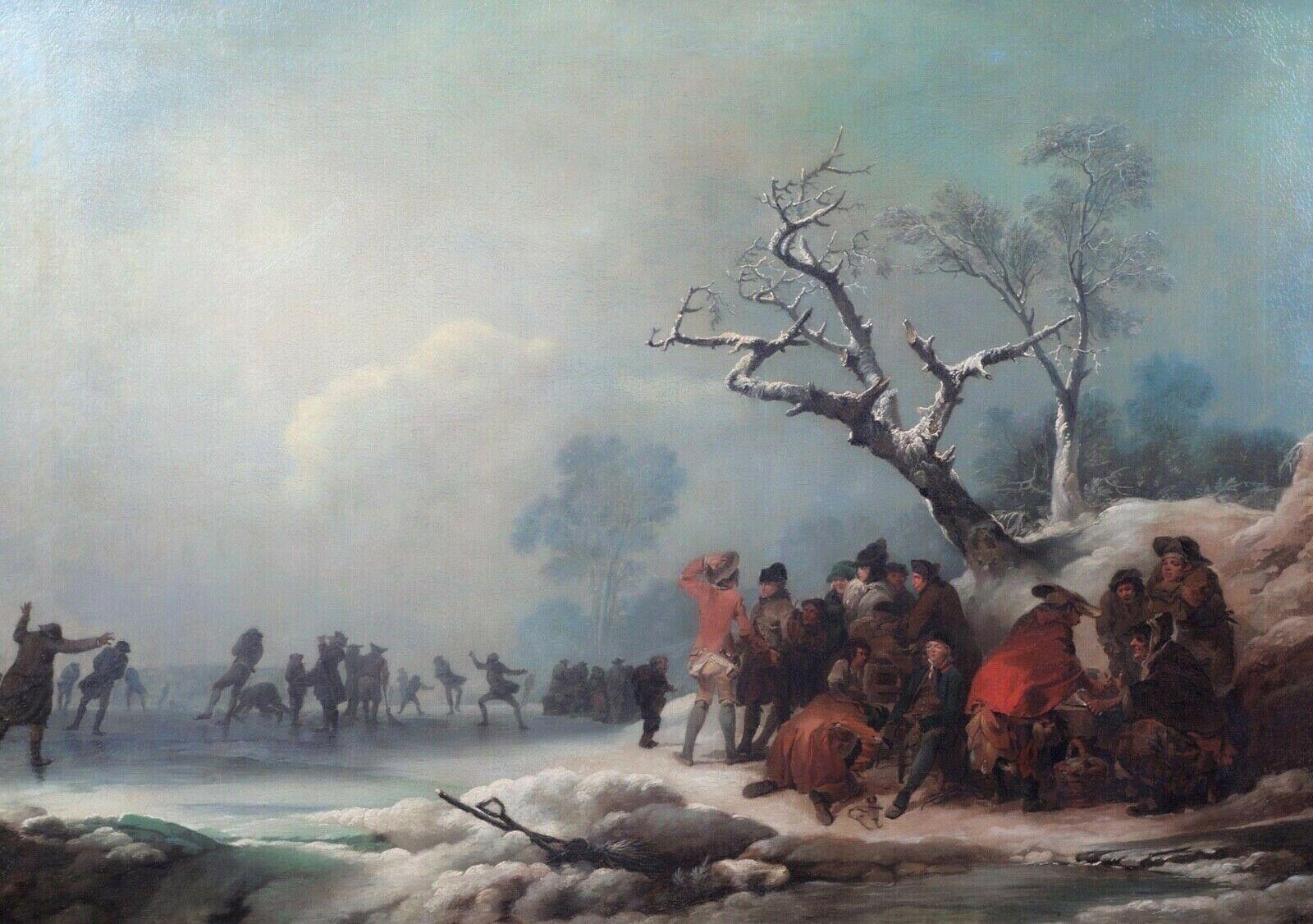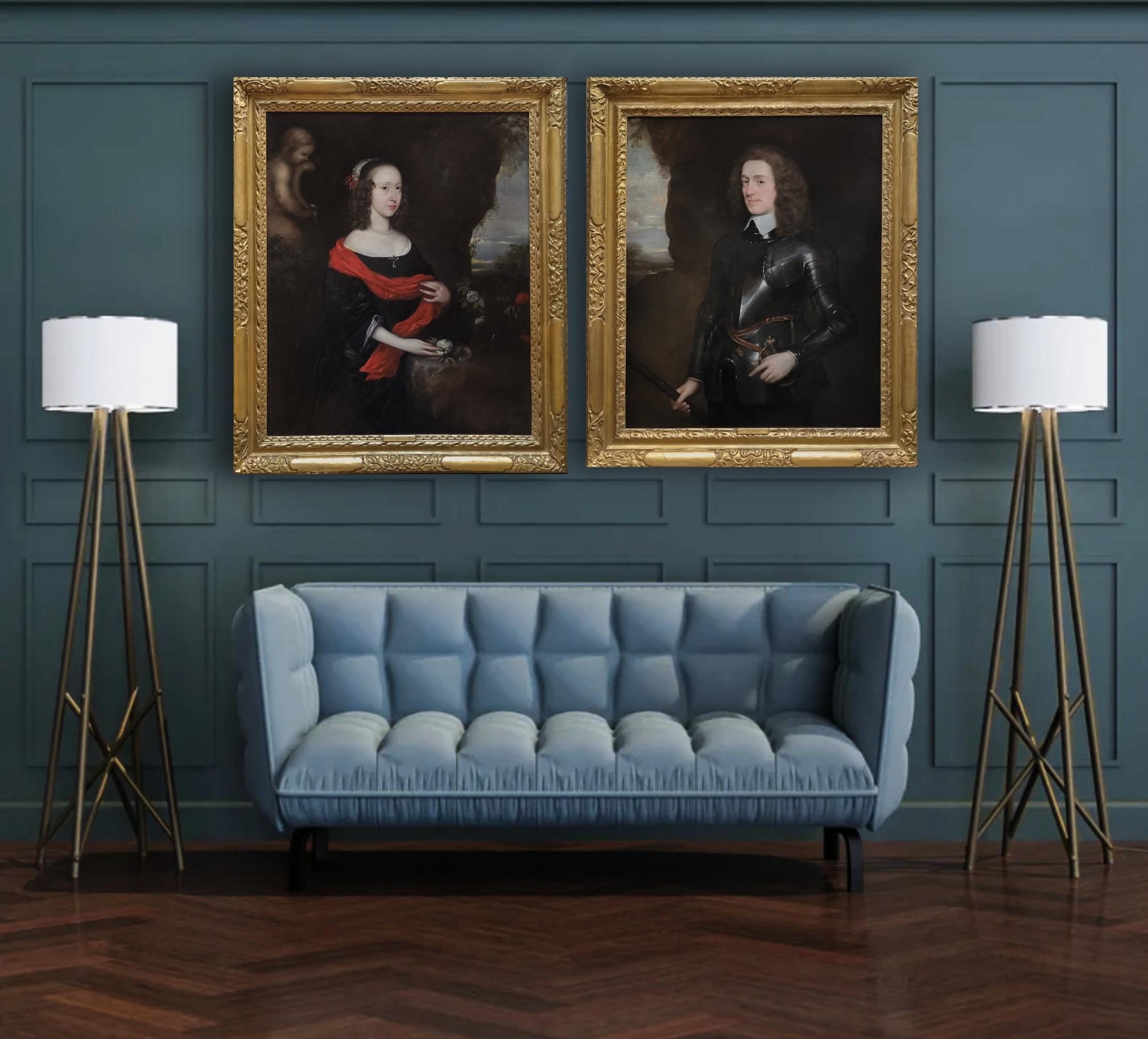Items Similar to An animated village near the river
Want more images or videos?
Request additional images or videos from the seller
1 of 8
Jan-Frans BescheyAn animated village near the river
About the Item
Oil on canvas
We like to thank Dr. Jan de Maere for his help.
Certificate dating 10/04/2024 is available.
In Jan Frans Beschey's captivating painting, a lively village nestled alongside a winding river comes to vibrant life. Brushstrokes dance across the canvas, conjuring a scene bursting with activity and charm. As if plucked from a bustling day in the past, the village teems with the comings and goings of its inhabitants.
Amidst the picturesque landscape, figures traverse the streets, some leading their horses, others engaged in animated conversation. The river, a central artery of the scene, reflects the hustle and bustle of daily life, as small boats ferry passengers across its glistening surface. Each detail, meticulously rendered by Beschey's skilled hand, invites the viewer to immerse themselves in the scene, to feel the sun's warmth on their skin and the gentle breeze off the water.
True to Beschey's signature style, the palette is a symphony of rich hues — from the tranquil blues of the river to the earthy browns of the village's architecture, punctuated by vibrant pops of reds and greens. These colors not only lend visual depth but also evoke a sense of nostalgia, transporting the observer to a bygone era of pastoral tranquility and rustic charm.
Jan Frans Beschey, a luminary in his own right, was part of a remarkable artistic lineage, counting among his siblings esteemed painters such as Balthasar, Carel, and Jozef Hendrik. Beyond his prowess with the brush, Beschey's legacy extended to the world of art dealing, where he left an indelible mark, particularly in the bustling art scene of London. Through works like this animated village scene, Beschey's art continues to captivate audiences, offering a timeless glimpse into a world alive with color, motion, and the timeless beauty of everyday life.
- Creator:Jan-Frans Beschey (1717 - 1799, Flemish)
- Dimensions:Height: 14.57 in (37 cm)Width: 18.51 in (47 cm)
- Medium:
- Movement & Style:
- Period:
- Condition:
- Gallery Location:Gent, BE
- Reference Number:1stDibs: LU2239214415162
About the Seller
No Reviews Yet
Vetted Seller
These experienced sellers undergo a comprehensive evaluation by our team of in-house experts.
Established in 1999
1stDibs seller since 2022
- ShippingRetrieving quote...Ships From: Gent, Belgium
- Return PolicyThis item cannot be returned.
More From This SellerView All
- Mary Magdalene praying in her caveLocated in Gent, BEImmerse yourself in the serene spirituality and masterful technique of David Teniers the Elder with this evocative depiction of Mary Magdalene in her cave. Trained under the tutelage...Category
17th Century Old Masters Figurative Paintings
MaterialsOil, Panel
- The temptation of Saint AnthonyLocated in Gent, BEThe temptation of Saint Anthony - Attributed to Cornelis de Baeillieur Oil on copper Cornelis de Baellieur the Elder was an Antwerp painter who was strongly influenced by Frans Fran...Category
17th Century Old Masters Paintings
MaterialsCopper
- Still life with playing cards, coral and shells - Carstian Luyckx (1623-1658)Located in Gent, BEStill life with playing cards, coral, shells, a jewelry box and a stone sculpture Oil on canvas We'd like to thank dr. Fred Meijer for his attribution. Carstian Luyckx was a 17th ...Category
17th Century Old Masters Still-life Paintings
MaterialsOil
- A bird concertLocated in Gent, BEOil on panel We'd like to thank dr. Jan De Maere for his advice. The exquisite detail and vibrant composition of this painting attributed to Jan Baptist Bouttats, show a versatile ...Category
17th Century Old Masters Animal Paintings
MaterialsOil, Panel
- Two Sunny animated landscapes with travellers with a river view, a town beyondLocated in Gent, BEOil on panel Comes with a certificate by dr. Jan De Maere "In my opinion they are early works, inspired by the river views of Jan Griffier the Elder, the italianate coulisses by Dir...Category
Early 18th Century Old Masters Landscape Paintings
MaterialsOil, Panel
- The robberyLocated in Gent, BEOil on copper Step into the world of Christoffel van den Berghe with this captivating small painting titled "The Robbery." This intriguing scene unfolds within a lush forest, where...Category
17th Century Old Masters Landscape Paintings
MaterialsCopper
You May Also Like
- 19th century English portrait of a White/grey hunter in a stableBy Charles TowneLocated in Woodbury, CTEnglish 19th century portrait of a White / Grey hunter in a stable. Charles Towne was born in Wigan in 1763. He was trained as a coach painter, and by ...Category
1820s Old Masters Animal Paintings
MaterialsOil, Canvas
- Portrait of a Lady, Maria Virginia Borghese Chigi Princess Farnese Oil on canvasLocated in London, GBThis exquisite portrait, presented by Titan Fine Art, belongs to a type of portrait known as ‘Les Belle Romanes’; Voet is perhaps best remembered for his series of them – a great set of portraits...Category
17th Century Old Masters Portrait Paintings
MaterialsCanvas, Oil
- Portrait Lady in Red Silk Dress c.1710, Michael Dahl, oil on canvas paintingBy (Circle of) Michael DahlLocated in London, GBThis charming work is a good example of the type of portrait in vogue during the first quarter of the eighteenth century in Britain. The sitter, portrayed bust-length, wears a russet silk dress over a white chemise...Category
18th Century Old Masters Portrait Paintings
MaterialsCanvas, Oil
- Portrait of a Lady, Katherine St Aubyn, Godolphin, Cornelius Johnson, Oil canvasBy Cornelius JohnsonLocated in London, GBTitan Fine Art are pleased to present this charming bust-length portrait, which is a good example of the style of portrait painted in England in the second quarter of the seventeenth century. The attire consists of the finest silks, and the full billowing sleeves, bows, and hairstyle help in dating this portrait to circa 1637. The accessory par excellence – pearls – are worn as a necklace and were a very popular accessory. The artist makes no attempt to obey the rules of Baroque and instead sensitively depicts in complete honesty his sitter against a plain wall, and without distracting backdrops and flowing draperies – this work is very redolent of the sumptuous half-length female portraits that Cornelius Johnson...Category
17th Century Old Masters Portrait Paintings
MaterialsCanvas, Cotton Canvas, Oil
- Figure Ice Skating In Hyde Park, 18th Century Philip Jakob II DE LOUTHERBOURGLocated in Blackwater, GBFigure Ice Skating In Hyde Park, 18th Century Philip Jakob II DE LOUTHERBOURG (1740-1812) Fine huge 18th century Old Master morning frozen winter landscape of figures skating at Hyde Park, oil on canvas. Stunning large scale superb quality and condition winter scene with figures skating on the frozen water. Though unsigned the style and detail is unmistakably De Loutherbourg with a very similar composition currently held in the UK Government Art Collection (Whitehall & Downing Street...Category
18th Century Old Masters Figurative Paintings
MaterialsCanvas, Oil
- Pair (2) Portraits Gentleman & Lady, William & Rachel Helyar c.1656, Civil WarBy Robert WalkerLocated in London, GBPortrait of Colonel William Helyar (1621-1698) and Rachel Helyar (c.1633-1678) c.1656 Circle of Robert Walker (act. 1637-1656) These fascinating portraits, presented by Titan Fine Art, depict Colonel William Helyar, High Sheriff of Somersetshire, and his wife Rachel Helyar nee Wyndham, a daughter and co-heiress of Sir Hugh Wyndham, 1st Baronet (died 1663) of Pilsden Court, Dorset. They are exquisite examples of portraiture during the Interregnum when England was under various forms of republican government. The history of the seventeenth century is in part the story of the Stewarts and their approach to government and the church; their ebbing and flowing popularity and the disastrous decisions that led to Civil War. But another fascinating dynasty also ruled Britain: the Cromwell’s. Between 1653 and 1659, following the Civil Wars and experimental Commonwealth, Oliver Cromwell governed as Lord Protector followed by his son Richard. Cromwell’s Protectorate is usually imagined as a grey, joyless, military regime. But the reality was rather different. Cromwell presided over a colourful and fashionable court where music and the arts flourished, masques were revived and the first English operas performed. Too often the London of the 1650s is painted as puritanical and repressive in contrast to the vivid, fun-loving capital of the Restoration. Yet, under Cromwell, this was the city where the first coffee houses were opening, where a young Samuel Pepys was embarking on his career as a civil servant with the patronage of one of Cromwell’s councillors and where Christopher Wren was enjoying his new Chair of astronomy at Gresham College, appointed after the personal intervention of Cromwell. When Cromwell was invested as Lord Protector for the second time in 1657, the lavish ceremony in Westminster Hall and procession through London matched any previous coronation for pageantry with thousands lining the streets, bells ringing, bonfires blazing and free French wine flowing through the city. The gentleman in our portrait is Colonel William Helyar (1621-1698), Sheriff of Somerset and as a Royalist during the English Civil War. As one of the most prominent old families of the South-West, the Helyar’s family roots in Somerset can be traced back to 1616 when the Reverend William Helyar (1559-1645), chaplain to Elizabeth I, who was also a cousin by marriage, purchased the family residence Coker Court in East Coker, Somerset. He married a Devonshire heiress and several estates were bestowed on him as a result. He was a warm supporter of Charles I in the Civil War and was in residence at Exeter in 1643 when the Parliamentarians pillaged the cathedral. Elderly as he was, he boldly resisted them, but was beaten, pelted with mud, and locked up in a ship in the port and only let out on payment of £800. He retired to Coker where he died in 1645. His eldest son Henry died in 1634 and he was succeeded by his grandson, Colonel William Helyar, the sitter in our portrait. Colonel Helyar raised a troop of horse for King Charles I and was a colonel in the king's army. He was at Exeter when it was captured by the Parliamentary forces in 1646 and thus deemed ‘Traitor to the Parliament’. His estates were sequestered, but they were returned and he was discharged and pardoned on payment of £1,522. During the Restoration he was a Sheriff and he also helped James II repel the Monmouth Rebellion. The companion portrait represents the Colonel’s wife, Rachel Helyar (baptised 24th June 1633 at St Mary Aldermanbury, London – died 1678). She was the youngest daughter and co-heir of Sir Hugh Wyndham, 1st Baronet of Pilsdon Court and Mary Wyndham nee Alanson (Sir Hugh should not be confused with his first cousin once removed from Somerset, also Sir Hugh Wyndham (bef. 1604 - 1684). Rachel is a thirteenth generation descendant of King Henry III. The couple resided at the family seat of Coker Court (interestingly, within the churchyard, lie the remains of the poet T.S. Eliot who once wrote a poem about East Coker). A marriage settlement in extant shows that the couple were married in 1656; the portraits were most likely painted to mark this important event in the sitter’s lives. Rachel holds roses, the flower of love, and the putto pouring water is representative of her purity, and possibly, the plighting of troth. Colonel Helyar wears a gold wedding band. The couple had four sons: George, William (MP) (1662-1742), John, and Richard. Colonel Helyar died in December 1697 and was buried at Whitechurch, Dorset 2 Jan 1698. This period in which this portrait was painted was known as the Protectorate (1653-1659). This period offered relative peace, as the English Civil War ended in 1651. It was an interesting time for portraiture in England and Scotland – in between the great artistic geniuses and dominance of Van Dyke and Peter Lely. Much of the foreign-born artistic talent had fled England and Scotland during the Civil War and the artists that had remained were in great demand, in part due to the newly exposed strata of society wishing to be painted. Sitters on both sides were depicted in portraits in very similar ways. They are not, on the whole, shown as the Roundheads and Cavaliers of popular history. In fact, it is usually impossible to guess their political allegiances from the style of their portrait and their Parliamentarian and royalist iconographies, as portraits on both sides followed the same conventions and looked identical. Colonel Helyar has been depicted in armour and holding a Marshal’s baton of command, confirming his status. There is a great sense of realism and a particular delicacy, note the finely rendered hand resting on the rapier. Rachel is wearing a satin dress with expansive sleeves and a crimson drapery over her shoulder and held up by her left hand. She wears large pearl...Category
17th Century Old Masters Portrait Paintings
MaterialsCanvas, Oil





